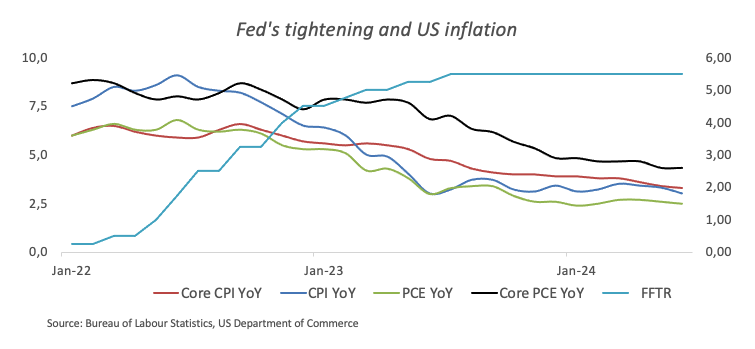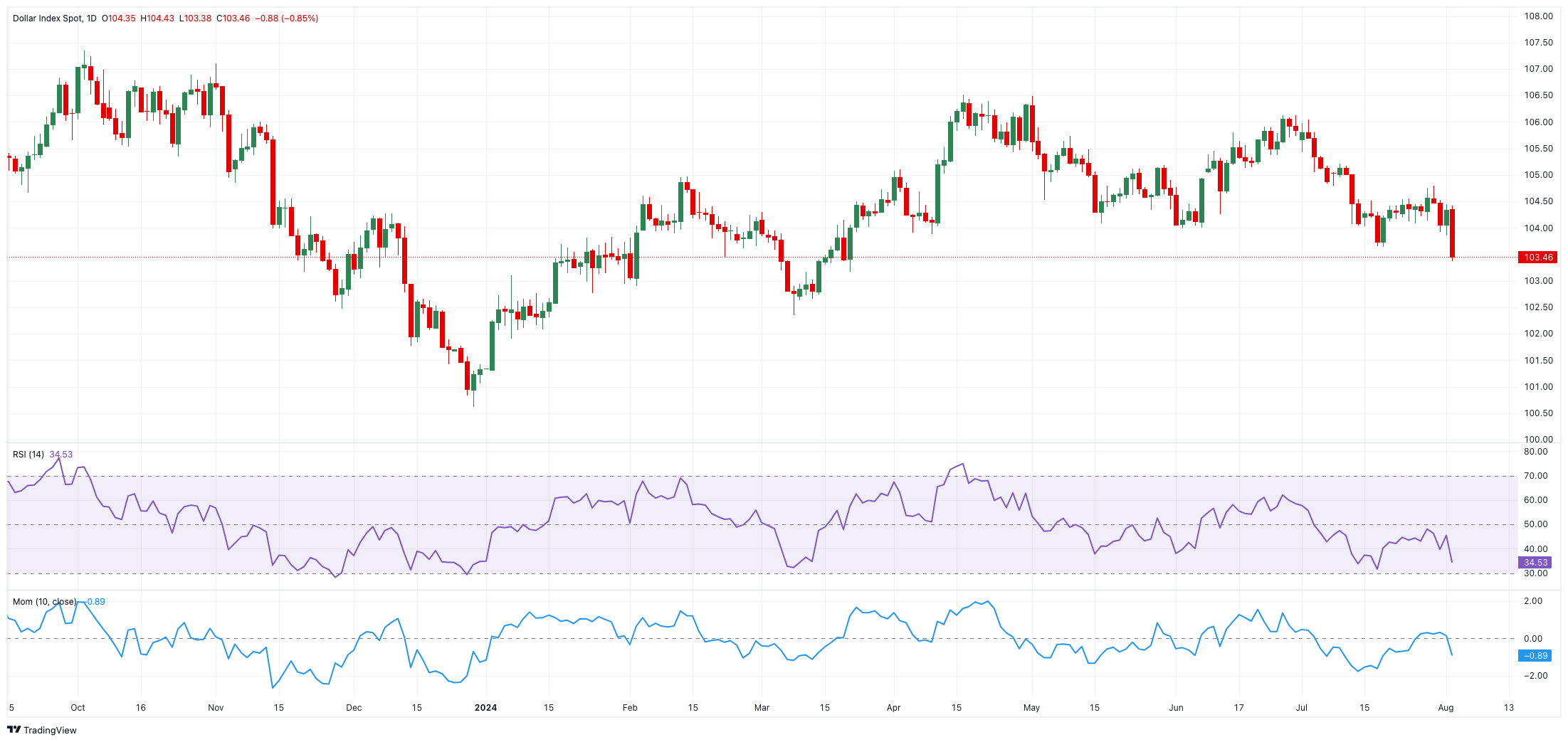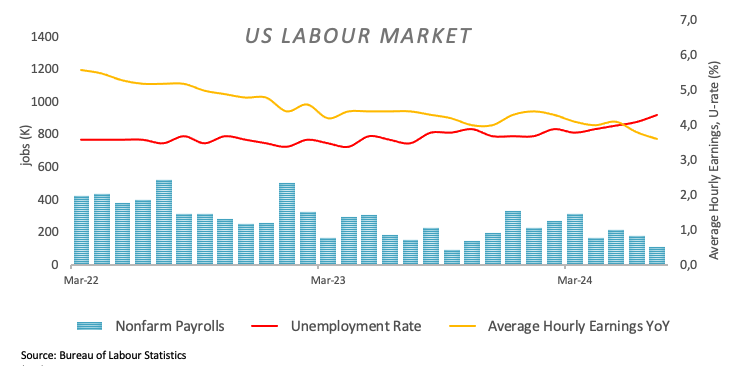- US Dollar Index (DXY) revisited five-month lows on Friday.
- The US NFP missed estimates at 114K in July.
- Bets for a 50 bps rate cut in September gather steam.
Attention now shifts to the downside
The Greenback has traded within a bearish performance this week, with the USD Index (DXY) accelerating its decline and revisiting the 103.40 zone towards the end of the week, particularly in response to the demoralizing prints of the US labour market report for the month of July.
The price action around the US Dollar (USD) initially followed developments around the Japanese Yen, while fresh geopolitical worries and reignited concerns surrounding a potentially incipient slowdown of the US economy contributed to fresh inflows into the currency amidst broader safe haven demand in the latter half of the week.
The Fed’s divergence in monetary policy remains in place
Price action around the Greenback has been mostly focused on the Japanese Yen following past FX interventions and the unexpected rate hike by the Bank of Japan (BoJ) at its July 31 meeting.
While the Federal Open Market Committee (FOMC) gathering on July 31 reiterated that the Committee needed to see further evidence that US inflation is headed towards the bank’s 2% goal, Chief Jerome Powell suggested that an interest rate reduction in September could be considered if progress in inflation remained in place.

However, it's worth noting that speculation about a September interest rate cut has suddenly and sharply increased following the release of US inflation figures, as measured by the Consumer Price Index (CPI), which indicated a renewed disinflationary trend in June.
Additionally, inflation measured by the Personal Consumption Expenditure (PCE) showed a decline in the headline figure over the past twelve months (2.5% compared to May’s 2.6%) while remaining steady in the core reading (2.6% vs. May’s 2.6%).
Meanwhile, the European Monetary Union (EMU), Japan, Switzerland, and the United Kingdom are all facing increasing disinflationary pressures.
In response, the European Central Bank (ECB) cut rates by 25 bps in June and maintained a dovish stance in July, with policymakers hinting at the possibility of another rate cut later in the year. Additionally, the Swiss National Bank (SNB) unexpectedly cut rates by 25 bps on June 20, and the Bank of England (BoE) reduced its policy rate by a quarter-point on August 1. In contrast, the Reserve Bank of Australia (RBA) is expected to start its easing cycle at some point in Q1 2025, while the Bank of Japan (BoJ) surprised everybody after delivering a hawkish message on July 31 after hiking rates by 15 bps to 0.25%.
Rate cuts vs. a hard landing
The increasing market speculation about an earlier start to the Fed's easing cycle has been supported by the persistent decline in domestic inflation, alongside a gradual cooling in key areas such as the labour market and the manufacturing sector.
On the latter, disheartening prints from July’s Nonfarm Payrolls (+114K) now seem to have shifted investors’ attention to the probability of a half-point reduction at the September 18 gathering.
According to the FedWatch Tool by CME Group, a 25 bps interest rate cut at the September 18 meeting hovers around 32% vs. nearly 68% of chances of a 50 bps reduction.
It is worth recalling that at the Fed’s latest event on July 31, Chair Powell emphasized the need for greater confidence in controlling inflation, citing Q2 inflation readings as supportive evidence. He noted that the bank is moving closer to a potential rate cut. Powell mentioned that if inflation continues to decrease, economic growth remains strong, and the labor market remains stable, a rate cut could be considered, possibly in September.
The Greenback reacted negatively to Powell’s dovish tilt, but concerns about a potential slowdown in US economic activity lent support to the currency later in the week. This was driven by a larger-than-expected increase in weekly Jobless Claims and an additional contraction in the ISM Manufacturing PMI, all contributing to rising inflows into safe-haven assets.
However, in the longer term, the increasing likelihood of another Trump administration and the potential reintroduction of tariffs could disrupt or even reverse the current disinflationary trend in the US economy, potentially shortening the Federal Reserve's easing cycle.
US yields maintain their negative trend
The performance of the US money market demonstrated an accelerated downward trend in yields across various time frames over the past week. That said, benchmark 10-year yields fell below the 4.0% mark for the first time since early February, while the short end retreated to levels last seen in mid-May 2023, near 4.10%.

Upcoming key events
The US service sector will be at the center of the debate next week on a pretty light US calendar. Against that, the final S&P Global Services PMI will come first, followed by the more significant ISM Services PMI, while the Fed’s rate setters, Mary Daly and Thomas Barkin, will kick off the monthly round of Fed speakers.
Techs on the US Dollar Index
The DXY broke below the key 200-day SMA around 104.30 with certain conviction, paving the way for the continuation of the downtrend, at least in the near term. While below this key region, the outlook for the Greenack is predicted to remain bearish.
If bears regain the initiative, the US Dollar Index (DXY) might initially drop to its weekly/monthly low of 103.38 (August 2), ahead of the March low of 102.35 (March 8). Further south, the December low of 100.61 (December 28) comes before the psychological barrier of 100.00.
On the flip side, DXY confronts immediate resistance at the weekly high of 104.79 (July 30), which appears propped up by the temporary barriers at the 100-day and 55-day SMAs at 104.83 and 104.90, respectively. Once this region is cleared, DXY could embark on a probable advance to the June top of 106.13 (June 26), ahead of the 2024 peak of 106.51 (April 16).

US Dollar PRICE Today
The table below shows the percentage change of US Dollar (USD) against listed major currencies today. US Dollar was the strongest against the Canadian Dollar.
| USD | EUR | GBP | JPY | CAD | AUD | NZD | CHF | |
|---|---|---|---|---|---|---|---|---|
| USD | -0.92% | -0.63% | -1.40% | -0.22% | -0.48% | -0.44% | -1.00% | |
| EUR | 0.92% | 0.28% | -0.39% | 0.69% | 0.43% | 0.47% | -0.08% | |
| GBP | 0.63% | -0.28% | -0.70% | 0.42% | 0.14% | 0.20% | -0.34% | |
| JPY | 1.40% | 0.39% | 0.70% | 1.13% | 0.84% | 0.88% | 0.34% | |
| CAD | 0.22% | -0.69% | -0.42% | -1.13% | -0.27% | -0.21% | -0.76% | |
| AUD | 0.48% | -0.43% | -0.14% | -0.84% | 0.27% | 0.05% | -0.50% | |
| NZD | 0.44% | -0.47% | -0.20% | -0.88% | 0.21% | -0.05% | -0.53% | |
| CHF | 1.00% | 0.08% | 0.34% | -0.34% | 0.76% | 0.50% | 0.53% |
The heat map shows percentage changes of major currencies against each other. The base currency is picked from the left column, while the quote currency is picked from the top row. For example, if you pick the US Dollar from the left column and move along the horizontal line to the Japanese Yen, the percentage change displayed in the box will represent USD (base)/JPY (quote).
Information on these pages contains forward-looking statements that involve risks and uncertainties. Markets and instruments profiled on this page are for informational purposes only and should not in any way come across as a recommendation to buy or sell in these assets. You should do your own thorough research before making any investment decisions. FXStreet does not in any way guarantee that this information is free from mistakes, errors, or material misstatements. It also does not guarantee that this information is of a timely nature. Investing in Open Markets involves a great deal of risk, including the loss of all or a portion of your investment, as well as emotional distress. All risks, losses and costs associated with investing, including total loss of principal, are your responsibility. The views and opinions expressed in this article are those of the authors and do not necessarily reflect the official policy or position of FXStreet nor its advertisers. The author will not be held responsible for information that is found at the end of links posted on this page.
If not otherwise explicitly mentioned in the body of the article, at the time of writing, the author has no position in any stock mentioned in this article and no business relationship with any company mentioned. The author has not received compensation for writing this article, other than from FXStreet.
FXStreet and the author do not provide personalized recommendations. The author makes no representations as to the accuracy, completeness, or suitability of this information. FXStreet and the author will not be liable for any errors, omissions or any losses, injuries or damages arising from this information and its display or use. Errors and omissions excepted.
The author and FXStreet are not registered investment advisors and nothing in this article is intended to be investment advice.
Recommended Content
Editors’ Picks
EUR/USD fluctuates above 1.0900 amid cautious optimism

EUR/USD continues to trade in a narrow channel above 1.0900 on Friday. The pair finds support from a weak US Dollar and negative US Treasury bond yields but lacks bullish conviction amid US growth concerns and looming Middle East geopolitical risks.
GBP/USD pulls away from daily highs, trades below 1.2750

GBP/USD loses its traction and trades below 1.2750 after advancing toward 1.2800 earlier in the day. The US Dollar struggles to gather further strength, with the US T-bond yields pushing lower, helping the pair limit its losses.
Gold holds steady above $2,420 as US yields edge lower

Gold struggles to build on Thursday's strong gains but manages to hold comfortably above $2,420 on Friday. The benchmark 10-year US Treasury bond yield falls more than 1% on the day and allows XAU/USD to hold its ground.
Bitcoin could decline following retest of key resistance level

Bitcoin's price retests the key resistance zone at $62,066, and rejection may continue to drive its downtrend. Ethereum's price experiences a brief rise before a potential downtrend continues.
Week ahead – US CPI to test market nerves, RBNZ might cut rates

The panic about the US economy being on the verge of a recession has mostly eased but markets remain jittery. Investors see a real risk that the Fed’s delay in cutting rates has made a downturn inevitable.
